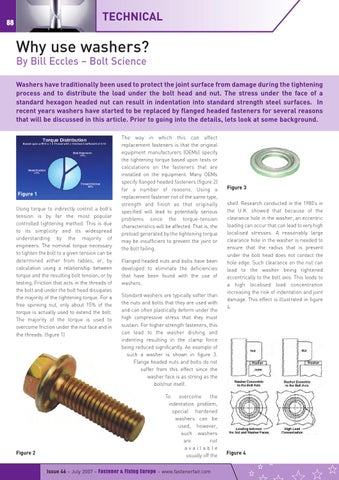TECHNICAL
88
Why use washers? By Bill Eccles – Bolt Science Washers have traditionally been used to protect the joint surface from damage during the tightening process and to distribute the load under the bolt head and nut. The stress under the face of a standard hexagon headed nut can result in indentation into standard strength steel surfaces. In recent years washers have started to be replaced by flanged headed fasteners for several reasons that will be discussed in this article. Prior to going into the details, lets look at some background.
Figure 1 Using torque to indirectly control a bolt’s tension is by far the most popular controlled tightening method. This is due to its simplicity and its widespread understanding by the majority of engineers. The nominal torque necessary to tighten the bolt to a given tension can be determined either from tables, or, by calculation using a relationship between torque and the resulting bolt tension, or by testing. Friction that acts in the threads of the bolt and under the bolt head dissipates the majority of the tightening torque. For a free spinning nut, only about 15% of the torque is actually used to extend the bolt. The majority of the torque is used to overcome friction under the nut face and in the threads. (figure 1)
Figure 2
The way in which this can affect replacement fasteners is that the original equipment manufacturers (OEMs) specify the tightening torque based upon tests or calculations on the fasteners that are installed on the equipment. Many OEMs specify flanged headed fasteners (figure 2) for a number of reasons. Using a replacement fastener not of the same type, strength and finish as that originally specified will lead to potentially serious problems since the torque-tension characteristics will be affected. That is, the preload generated by the tightening torque may be insufficient to prevent the joint or the bolt failing. Flanged headed nuts and bolts have been developed to eliminate the deficiencies that have been found with the use of washers. Standard washers are typically softer than the nuts and bolts that they are used with and can often plastically deform under the high compressive stress that they must sustain. For higher strength fasteners, this can lead to the washer dishing and indenting resulting in the clamp force being reduced significantly. An example of such a washer is shown in figure 3. Flange headed nuts and bolts do not suffer from this effect since the washer face is as strong as the bolt/nut itself. To overcome the indentation problem, special hardened washers can be used, however, such washers are not available usually off the
Issue 46 – July 2007 – Fastener & Fixing Europe – www.fastenerfair.com
Figure 3 shelf. Research conducted in the 1980’s in the U.K. showed that because of the clearance hole in the washer, an eccentric loading can occur that can lead to very high localised stresses. A reasonably large clearance hole in the washer is needed to ensure that the radius that is present under the bolt head does not contact the hole edge. Such clearance on the nut can lead to the washer being tightened eccentrically to the bolt axis. This leads to a high localised load concentration increasing the risk of indentation and joint damage. This effect is illustrated in figure 4.
Figure 4
